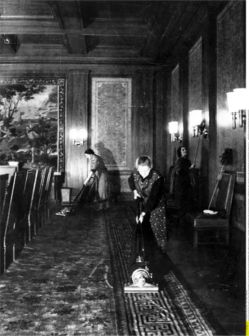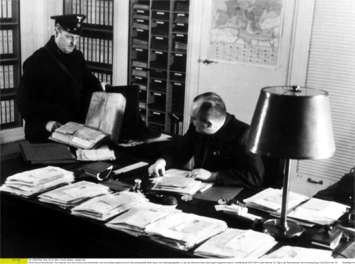
 A day in the Chancellery
A day in the Chancellery
Erich Peter Neumann (pseudonym Hubert Neun), a writer for the weekly newspaper
Das Reich, visited the Chancellery and recorded his impressions in issue
number 14, April 6th, 1941.
The front of the New Reich Chancellery
measures four hundred meters, and no one can walk by without wondering what goes
on inside…
The officials in their brown uniforms behind the massive
swinging doors know the government executives well. They recognize their faces
and the way they move, whether they are taciturn or friendly…On many days three
generals’ coats hang on coat hooks in the waiting room. On other days, the
checkroom is filled with the coats of Reichsleiter, Gauleiter, SA officials, or
armament inspectors. Sometimes civilians also check their coats.
The elevators are completely automatic, the doors opening and
closing noiselessly. Unerringly the guards appear and demand passes. Slowly the
eye accustoms itself to the unusual dimensions of Speer’s building, which are
constantly surprising the visitor. Anxiety generated by the long corridors
gradually dissipates. One begins effortlessly to orient oneself, and what one
hardly noticed on first pass becomes clear: the relationship between location
and way.
The visitor walks over thick carpets that muffle all sounds.
Here and there, yellow signs point to the air-raid shelter.
There are more than 400 rooms…In contrast to the size of the
chancellery, the number of officials, employees, and workers is small. Only
about seventy people are actually performing the tasks of government. The entire
staff consists of 250 people, but most are engaged in maintaining the building.
Employees stride up and down the steps with gray folders
under their arms. Cleaning ladies with innumerable whirring vacuum cleaners fill
the long marble halls. A workman is bent over repairing a damaged spot in the
floor…
 Like every other corporate office, the mailroom is the first
stop for much of the day’s business. Early in the morning the letter carrier
brings sacks of mail from the Leipzigerstraße post office to the third floor
chancellery mailroom. Many letters and packages are immediately forwarded to
their ultimate destination, while others must be evaluated. In 1932, 51,500
pieces of mail arrived. In 1933, the volume increased to 375,000. As
unemployment decreased, the flood of letters diminished to 200,000 annually and
has stabilized at that number...Every letter, no matter how important, is logged
in. If the Chancellery cannot answer it, the letter is forwarded to the
appropriate agency. In all cases the sender receives an acknowledgment with a
file number so that he may at any time inquire regarding the status of his
correspondence.
Like every other corporate office, the mailroom is the first
stop for much of the day’s business. Early in the morning the letter carrier
brings sacks of mail from the Leipzigerstraße post office to the third floor
chancellery mailroom. Many letters and packages are immediately forwarded to
their ultimate destination, while others must be evaluated. In 1932, 51,500
pieces of mail arrived. In 1933, the volume increased to 375,000. As
unemployment decreased, the flood of letters diminished to 200,000 annually and
has stabilized at that number...Every letter, no matter how important, is logged
in. If the Chancellery cannot answer it, the letter is forwarded to the
appropriate agency. In all cases the sender receives an acknowledgment with a
file number so that he may at any time inquire regarding the status of his
correspondence.
Along with official communications, every day brings a
mountain of letters from individuals. People from every corner of the Reich, and
foreigners as well, write about personal concerns. A glance at today’s pile
reveals the peculiar address designations: ‘To the Führer’s cabinet,’ ‘to the
Reich government and revered Führer,’ ‘To his Excellency the noble, high-born
Führer,’ ‘To the Obersalzberg in Berlin.’ The huge outpouring of opinion
provides a glimpse of the trust accorded Adolf Hitler by a broad swath of the
German population. The volume of letters from foreign countries is substantial,
and the foreigners’ letters, by and large, have the highly reverent addresses…
An ordinary chancellery day passes swiftly. Couriers come and go. The grand
rooms are often empty, but the offices are constantly busy, even more so since
the war began…One little office holds a cot for the night concierge. The
telephone switchboard is in operation twenty-four hours. A chancellery official
is always on call. The chancellery never closes.
Propaganda Minister Joseph Goebbels published the first issue of Das Reich
May 26th, 1940. Goebbels himself wrote many of the front-page articles in an
attempt to reach the educated classes, both inside and outside of Germany. Erich
Peter Neumann’s best-known article for Das Reich was a March 1941 report on the
Warsaw Ghetto, in which he described “the horribly repulsive variety of all
Jewish types in the East.” Neumann wrote Nazi propaganda for other publications,
including the Berliner Tageblatt and the Deutsche Allgemeine Zeitung.
After the war, Neumann continued to prosper by churning out anti-communist
propaganda for the West German government. With his wife, Elisabeth
Noelle-Neumann, who also wrote for Das Reich, Erich Neumann compiled opinion
surveys for Konrad Adenauer and founded the Deutsche Korrespondenz, a compendium
of foreign press clippings that was very popular among government officials.


